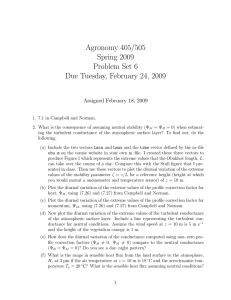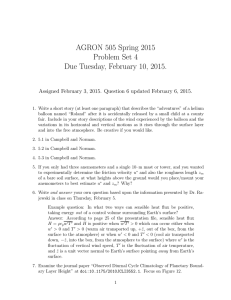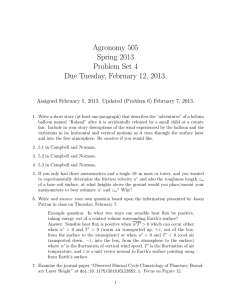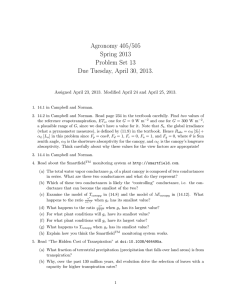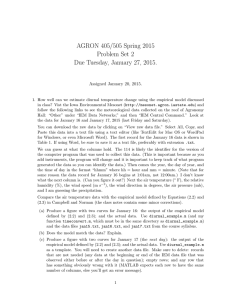AGRON 405/505 Spring 2015 Problem Set 6 Due Tuesday, February 24, 2015.
advertisement
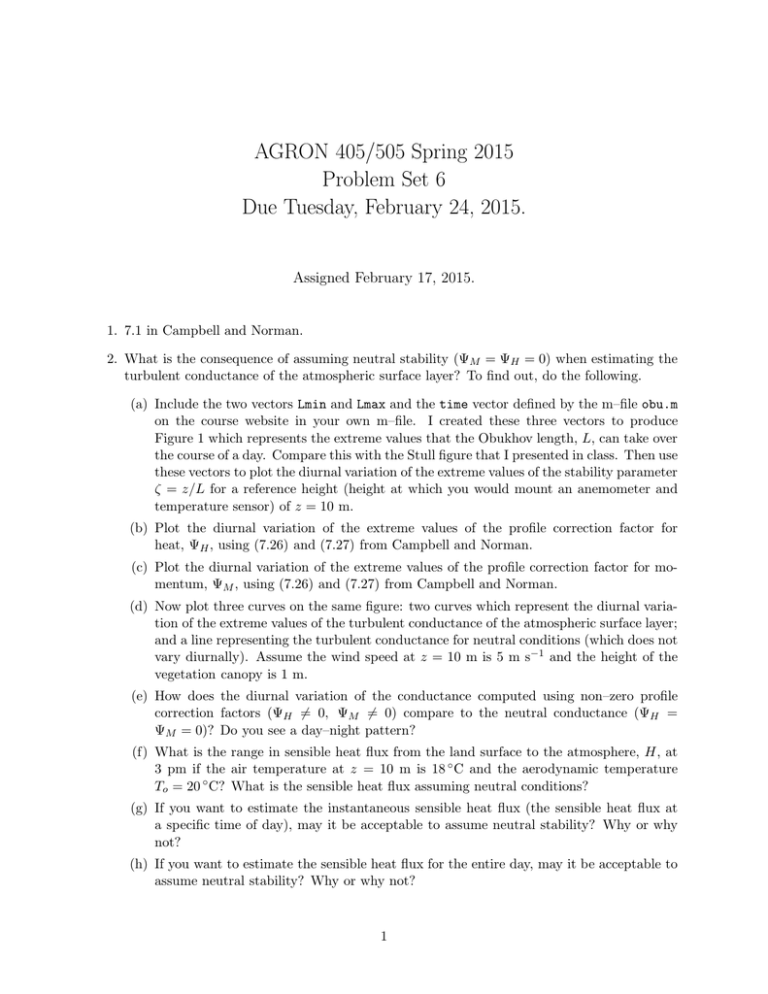
AGRON 405/505 Spring 2015 Problem Set 6 Due Tuesday, February 24, 2015. Assigned February 17, 2015. 1. 7.1 in Campbell and Norman. 2. What is the consequence of assuming neutral stability (ΨM = ΨH = 0) when estimating the turbulent conductance of the atmospheric surface layer? To find out, do the following. (a) Include the two vectors Lmin and Lmax and the time vector defined by the m–file obu.m on the course website in your own m–file. I created these three vectors to produce Figure 1 which represents the extreme values that the Obukhov length, L, can take over the course of a day. Compare this with the Stull figure that I presented in class. Then use these vectors to plot the diurnal variation of the extreme values of the stability parameter ζ = z/L for a reference height (height at which you would mount an anemometer and temperature sensor) of z = 10 m. (b) Plot the diurnal variation of the extreme values of the profile correction factor for heat, ΨH , using (7.26) and (7.27) from Campbell and Norman. (c) Plot the diurnal variation of the extreme values of the profile correction factor for momentum, ΨM , using (7.26) and (7.27) from Campbell and Norman. (d) Now plot three curves on the same figure: two curves which represent the diurnal variation of the extreme values of the turbulent conductance of the atmospheric surface layer; and a line representing the turbulent conductance for neutral conditions (which does not vary diurnally). Assume the wind speed at z = 10 m is 5 m s−1 and the height of the vegetation canopy is 1 m. (e) How does the diurnal variation of the conductance computed using non–zero profile correction factors (ΨH 6= 0, ΨM 6= 0) compare to the neutral conductance (ΨH = ΨM = 0)? Do you see a day–night pattern? (f) What is the range in sensible heat flux from the land surface to the atmosphere, H, at 3 pm if the air temperature at z = 10 m is 18 ◦ C and the aerodynamic temperature To = 20 ◦ C? What is the sensible heat flux assuming neutral conditions? (g) If you want to estimate the instantaneous sensible heat flux (the sensible heat flux at a specific time of day), may it be acceptable to assume neutral stability? Why or why not? (h) If you want to estimate the sensible heat flux for the entire day, may it be acceptable to assume neutral stability? Why or why not? 1 200 150 range of Obukhov length (L), m 100 50 0 −50 −100 −150 −200 0 3 6 9 12 time, hours 15 18 21 24 Figure 1: Diurnal variation of the Obukhov length, L. 3. 7.3 in Campbell and Norman. Remember that the total heat flux is equal to the sensible and latent heat flux. Assume the relative humidity of the room is 0.4. 4. 7.4 in Campbell and Norman. Assume that the tissue conductance of a sheep is 1 mol m−2 s−1 . Only estimate the sensible heat flux. 5. 7.5 in Campbell and Norman. 6. Read or listen to “Big-Beaked Toucans Play It Cool” at NPR (search for “toucans” or use link on course website) and then read the corresponding article in Science, doi:10.1126/ science.1175553. (a) As noted in the article, “As must any endothermic organism, toucans regulate their body tempeature primarily by balancing metabolic heat production with heat exchange with the environment.” What make a toucan’s bill a good candidate to be a “thermal regulator?” (b) What is allometry? (c) How does the temperature of the proximal and distal regions of the toucan’s beak change? (d) What do you think a “thermal neutral zone” is? (e) Vasodilation occurs when blood vessels increase in size to increase blood flow. What appears to happen at about 21 ◦ C? (f) What is the maximum percentage of resting heat production that can be dissipated by the bill? (g) What do toucans do at night to keep warm? (h) Wind speed makes a difference in the heat loss from the bill. Is this forced or free convection? 2
